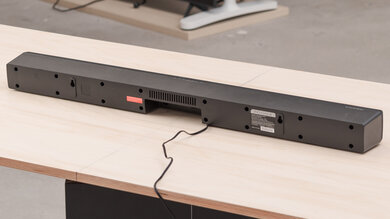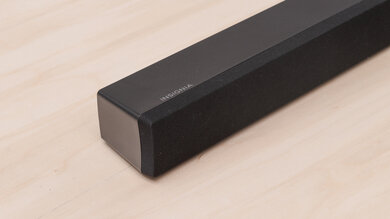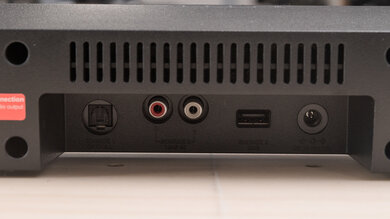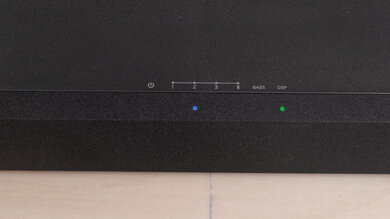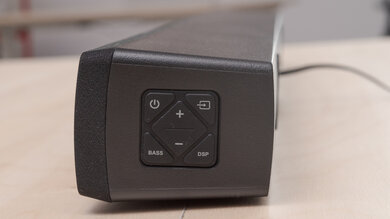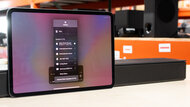The Insignia NS-HSB318 is a very simple, straightforward 2.0 soundbar. It's essentially a large Bluetooth speaker since it has limited inputs and functionality. It doesn't support surround sound and only works with PCM content when connected to your home theater system. It lacks both bass and treble, but it still does a decent job at making voices and most instruments sound fairly balanced. It can also get quite loud, especially for a smaller soundbar, and it doesn't compress very much at max volume, which is great. It can be a viable option if you're looking for a basic soundbar, so you can listen to music off your phone at a party or in the backyard, but it's otherwise not very versatile.
Our Verdict
The Insignia NS-HSB318 is disappointing for mixed usage. Its sound profile lacks punch in the bass range and brightness in the treble. It also doesn't support surround sound and doesn't have any HDMI ports. It still does a decent job at reproducing voices and instruments, though, and it's quite compact. It also gets quite loud without compressing, which is great for parties. It's not ideal if you want an immersive home theater experience, but it's alright if you're just looking to upgrade your TV or smartphone's integrated speakers.
-
Compact design.
-
Gets very loud without compressing.
-
Limited connectivity options.
-
No surround sound support.
-
Lacks a lot of bass.
The Insignia NS-HSB318 is decent for dialogue and TV shows. It reproduces voices quite accurately with its default sound profile. It also has a 'News' feature, which can help make dialogue even clearer. Unfortunately, it doesn't have automatic volume control or a night mode, but it's still a fair choice if you just want a basic soundbar to watch your favorite sitcoms with.
The Insignia NS-HSB318 isn't bad for music, but it's not the best. Its default sound profile lacks a lot of bass, so it's not ideal for genres with a lot of thump and rumble like EDM and hip-hop. It reproduces voices and instruments fairly accurately, though. It also has a Bass Boost feature which may help improve the bass performance; however, we didn't test this. That said, it can get quite loud without compressing, which is great.
The Insignia NS-HSB318 is bad for movies. It produces virtually no thump or rumble, so action movies lack excitement. It also doesn't support any surround sound formats - you need to make sure your TV is set to PCM format content only if you connect it via optical. This is disappointing since you won't be able to enjoy the surround experience of your favorite films.
- 5.2 Mixed Usage
- 5.4 Dialogue/TV Shows
- 6.3 Music
- 4.5 Movies
Changelog
- Updated Apr 07, 2021: Updated 'Bass Adjustment' to 'No' for greater clarity.
- Updated Apr 06, 2021: Converted to Test Bench 1.0.
- Updated Sep 23, 2020: The Dynamics tests have been reconducted due to a value input bug.
- Updated May 25, 2020: Review published.
- Updated May 20, 2020: Early access published.
Check Price
Compared To Other Soundbars
The Insignia NS-HSB318 2.0 Channel Soundbar is a disappointing soundbar overall, but it's a bit better than some of the other 2.0 models on the market. Although it lacks thump in the bass and brightness in the treble, it still sounds more balanced than the TaoTronics TT-SK023. It also gets much louder than the Bose Solo 5 and compresses less than the Vizio SB3220n-F6. Its connectivity options are very limited, though, especially compared to the JBL Link Bar. If you're interested in your other options, check out our recommendations for the best budget soundbars, the best small soundbars, and the best soundbars for dialogue.
The Sony HT-S100F is a better 2.0 soundbar than the Insignia NS-HSB318 2.0. Although its default sound profile isn't much better balanced, it supports Dolby Digital content over optical and HDMI ARC. Although it downmixes surround content, it has a virtual surround feature, which the Insignia lacks. The Insignia is more compact, which some may prefer.
The Insignia NS-HSB318 2.0 and the TaoTronics TT-SK023 are very similar soundbars, but the Insignia is better since it has a more balanced default sound profile. It also has a few more sound enhancement features. The TaoTronics feels less cheaply-made, though, and has an AUX port. The Insignia, on the other hand, can play files off a USB key or hard drive.
The Vizio SB3220n-F6 is a much better 2.0 soundbar than the Insignia NS-HSB318 2.0. It produces more bass, sounds better balanced, has a wider soundstage, and can play Dolby Digital files over optical. The Insignia feels more cheaply made and performs worse overall.
The Bose Solo 5 is a better 2.0 soundbar than the Insignia NS-HSB318 2.0. The Bose feels much better-built, has a more balanced, neutral sound profile, and supports Dolby Digital content over optical. However, the Insignia can get much louder and compresses less at max volume too. It also has a few more sound enhancement features, like EQ presets and a bass boost mode, too.
The Samsung HW-Q90R is a much better soundbar setup than the Insignia NS-HSB318 2.0. The Insignia is a single 2.0 channel soundbar, while the Samsung gives you a whopping 7.1.4 channels of audio. This results in a much more immersive listening experience, especially with Dolby Atmos content, which the Samsung soundbar supports. Even with regular stereo content, the Samsung sounds much better-balanced, with stronger bass and more brightness. The Insignia soundbar is much more compact, though, so it's a better choice if you're limited on space.
The Insignia NS-HSB318 2.0 is a better overall performing soundbar than the BOMAKER Odine II. While both soundbars are very similar in terms of build quality and downsampling audio formats into PCM, the Insignia is able to produce a bit more bass, and it has a Bass Boost feature, which is a nice touch. In comparison, the BOMAKER has more inputs as well as a virtual surround feature.
Test Results
This soundbar doesn't have a subwoofer.
This soundbar doesn't come with satellite speakers.
The Insignia NS-HSB318's build quality is okay. It isn't a high-end product, but it's not the cheapest-feeling soundbar we've reviewed, either. The bar is made of plastic, and has silicone buttons on the end. The fabric covering the front is prone to rips and tears, but it otherwise feels reasonably durable.
The Insignia 2.0 Channel Soundbar has a passable stereo frequency response. It produces virtually no rumble or thump in the bass range, and it lacks brightness in the higher frequencies, but the response in-between is quite well-balanced. This means that although it sounds a bit dull, it still does an adequate job reproducing voices, as well as most instruments.
The Insignia NS-HSB318's stereo soundstage is okay. It sounds a bit bigger than the bar itself, but it's not very wide. It has very good focus, though.
Update 09/23/2020: We've discovered a value input bug that would cause the Dynamics box results to be slightly off. All soundbars reviewed since January 30th, 2020 have been updated.
The Insignia 2.0 Channel Soundbar has great stereo dynamics. This soundbar can get surprisingly loud for its size, and doesn't compress very much either. This makes it a good choice for use in a large room or at parties.
This soundbar's total harmonic distortion performance is alright. At normal listening volumes, it has a clean and pure sound. However, at max volume, it distorts a bit more. It shouldn't be very noticeable, though.
The Insignia 2.0 Channel Soundbar doesn't have a center channel. It only supports PCM content, and can't decode or downmix surround content.
The Insignia 2.0 Channel Soundbar doesn't have surround speakers. It only supports PCM content, and can't decode or downmix surround content.
The Insignia 2.0 Channel Soundbar doesn't have height channels, nor does it support Atmos.
Update 04/07/2021: We updated our results for 'Bass Adjustment' from 'Yes' to 'No'. While this soundbar comes with a Bass Boost feature that you can turn on and off, we don't consider this to be a bass adjustment feature because it doesn't let you adjust the amount of bass.
The Insignia NS-HSB318 has limited sound enhancement features. There are two EQ presets, one of which is also a dialogue enhancer. There's also a Bass Boost mode, but it's only an on/off button - you can't adjust the amount of bass itself. If you're looking for a 2.0 setup with a virtual surround feature, check out the BOMAKER Odine II.
The Insignia 2.0 Channel Soundbar With Digital Amplifier has limited connectivity options. There's an optical-in for PCM format support and RCA for analog audio. You can also play files off a USB key or hard drive, but that's about it. Each input is numbered and the number corresponds to their input order on the display.
This soundbar doesn't have an HDMI ARC connection.
This soundbar doesn't have an HDMI input.
While this soundbar has an optical input, it only supports PCM formats. You need to change your TV settings to PCM for it to work.
The Insignia NS-HSB318's wireless playback options are okay. It supports Bluetooth, so you can stream music from a paired device like a tablet or smartphone. However, you can't connect seamlessly via Chromecast or AirPlay, nor can you play music from your PC over Wi-Fi.
This soundbar doesn't have any HDMI ports, so video passthrough isn't possible.
This soundbar doesn't come with satellite speakers.
This soundbar has a very basic visual interface. There are four numbers, each corresponding to an input, written on the back of the soundbar. When an input is active, a blue light appears under the appropriate number. However, it's rather annoying if you forget which number belongs to which input. The display also indicates whether the bass boost function or an EQ preset is active with a green light.
The Insignia NS-HSB318 comes with a very straightforward remote. It's short and wide, but pretty easy-to-use. You can switch between EQ presets, activate the bass boost mode, and mute the soundbar. You can also use it to play/pause and skip tracks while listening over Bluetooth or USB.
Comments
Insignia NS-HSB318 2.0: Main Discussion
Let us know why you want us to review the product here, or encourage others to vote for this product.




